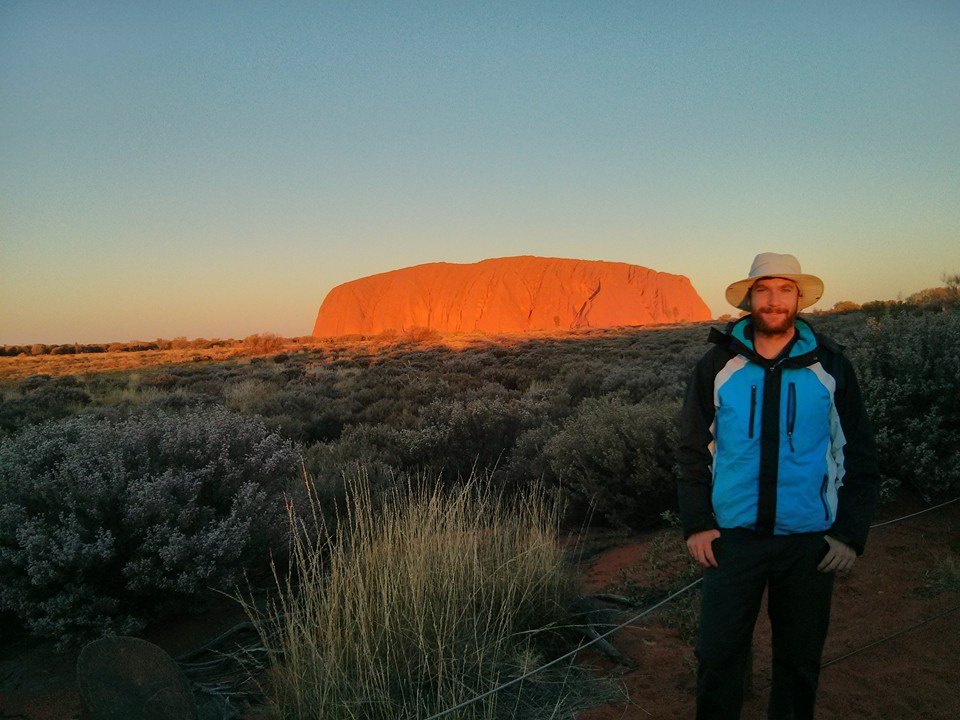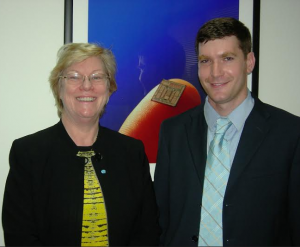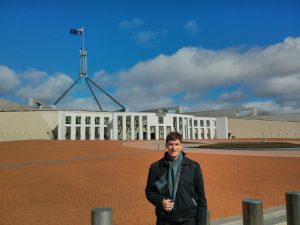
Yuriy Veytskin, 2013-2014, Australia, visiting Ayers Rock at Uluru-Kata Tjuta National Park
It was August of 2012 when I first heard about the opportunity that would change my life. How I heard about it was rather direct and unromantic: a simple email from the Fulbright Program Adviser at North Carolina State University, my alma mater, listing all of the science-related Fulbright Programs available that year. I had heard about Fulbright before, but the idea of applying for a grant in the middle of my PhD program seemed daunting and unrealistic. Setting all doubts aside, I figured I would ask my adviser for more information and take it from there. Little did I know, this would be the start of two months of dedicated, and at times frantic, application writing in order to meet the internal university and national deadlines. Unlike some other applicants, I started my application quite late and only had about five weeks to submit all of my materials by the internal campus deadline. Unfazed, I worked diligently for hours to complete my Fulbright application while also taking my graduate courses. For my affiliation letter, I cold emailed a few scientists in my potential host country, Australia, hoping that they might forward my request to the appropriate contacts. The affiliation letter I received ended up being highly detailed and focused, signed by my three prospective advisers, and was likely a major contributing factor to the success of my application.
After going through countless iterations of my Statement of Grant Purpose and Personal Statement with the assistance of my Fulbright Program Adviser, I was able to submit my application by the internal university deadline.
After my campus interview, I honestly felt like I didn’t stand a chance of getting a Fulbright. The edits to my application seemed too significant and needed to be made within too short a time frame to end up with a polished product. As is often the case with science applicants who plan on working in a lab during their grants, figuring out how to engage with your proposed local host community, and emphasizing how you’ll do that throughout your application, is challenging. I was also proposing a project in which I had no immediate experience that I could point to (although it was directly related to my PhD adviser’s former research). I would need to start from the ground up to understand rock mechanics and shale within an Australian context (no pun intended).

Yuriy Veytskin, 2013-2014, Australia (right), with the former Chief Executive of CSIRO, Megan Clark, in Parkville Site, Melbourne
To my amazement, I was awarded the sole Commonwealth Scientific and Industrial Research Organisation (CSIRO) Postgraduate Fulbright Fellowship for the 2013-2014 academic year. I spent 12 months, in collaboration with the University of Melbourne and the CSIRO Energy Flagship, investigating the role of nanotechnology and the future of unconventional resources through my shale research, using microscale techniques to characterize shale by linking microstructure and mineralogy to bulk material properties and performance. The goal was to provide insights into how to improve the efficiency of hydraulic fracturing technology by understanding how fracking fluids flow through fractured gas shale reservoirs, and how the various chemical additives (e.g., viscosifiers and proppants) affect the accessibility of fracking fluids to the fracture network. As an unconventional resource, shale has the potential to be a game-changer as a global energy source. Exploring its merits contributes to one of CSIRO’s core goals of developing more sustainable energy and energy harvesting practices. Another pillar of Fulbright my research was the idea of stewardship of mineral resources through responsible mineral resource development, environmental management, and intelligent mining by motivating communities to be more aware of their local and global environments.

Yuriy Veytskin, 2013-2014, Australia, attending the Australian-American Fulbright Commission’s reception welcoming U.S. students at the Australian Parliament House
Living in Melbourne was one of the best parts of my Fulbright grant. As the sporting capital of the world, I was fortunate enough to attend the Australian Open tennis tournament, the Australian Grand Prix, the Melbourne Cup, and The Ashes. I became a follower of both Australian football and rugby. Throughout these events, I bonded with CSIRO and University of Melbourne colleagues, locals, and Australian and international visitors, while learning about Australia’s rich history and sporting culture.
Ultimately, collaborating with CSIRO, the University of Melbourne, and the Australian Resources Research Centre gave me invaluable, topflight research connections, enduring international collaborations, and an opportunity to position my career in several directions by incorporating a global component to my research. Fulbright also gave me scientific cultural competencies, an understanding of the pace and culture of Australian science organizations, an increased willingness to take research risks, and insights into cultural issues across the country. My Fulbright research was later published in a peer-reviewed journal, my methods and results are being applied in labs, and I am conducting similar research in my current position. I still communicate with friends and colleagues from my tenure in Australia, both personally and professionally; the Fulbright grant was truly life-changing.
To those looking to apply for the program, here is my advice:
- If you’re applying for a Fulbright U.S. Student Study/Research grant, don’t be afraid to seek affiliations in multiple cities in your selected host country, if necessary; it’s always a good idea to have a plan B, C, D…
- Work on obtaining an excellent affiliation letter that outlines the parameters of what you’ll be doing, who you’ll be working with, what you’ll be working on… And, make sure it’s on letterhead!
- Show how you will interact with your local host community (especially important in the sciences and STEM fields, where you may be in a lab much of the time during your grant)
- In your Personal Statement, don’t over-complicate your story. A single overarching theme carried through one powerful, cohesive personal story is better than attempting to pack your whole life into one page. Let your application tell your story!
Have questions for Yuriy about his Fulbright experiences in Australia and as a Fulbright Alumni Ambassador? You can reach him at Y.Veytskin.alumniambassador@fulbrightmail.org.

1 Comment
Awesome advice and story! Thanks for sharing a STEM study research perspective and a last minute perspective.